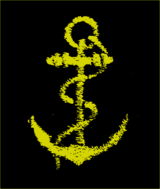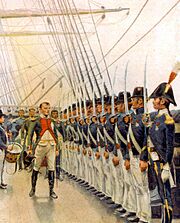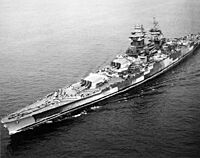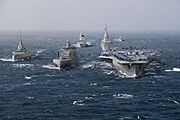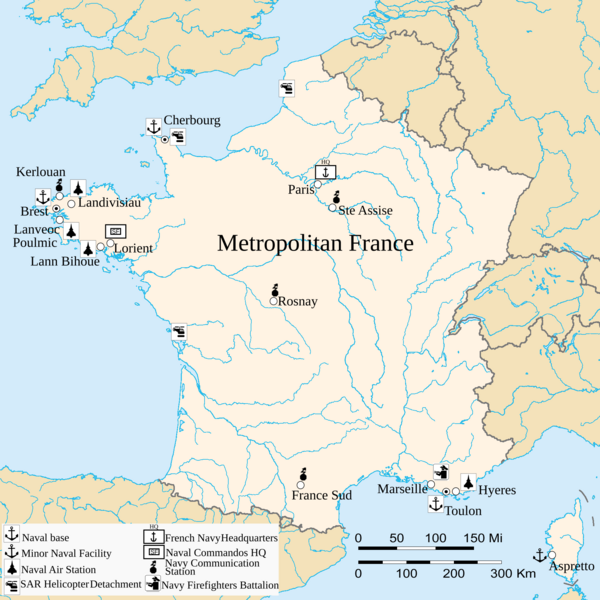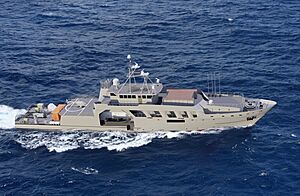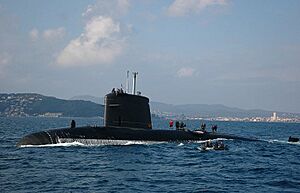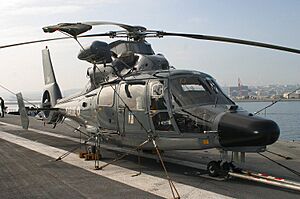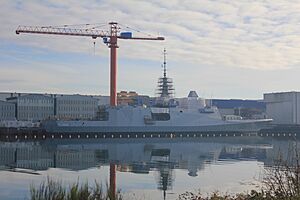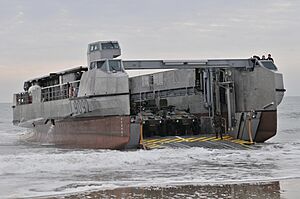French Navy facts for kids
Quick facts for kids French Navy |
|
|---|---|
| Marine nationale | |

Logo of the French Navy since 2021
|
|
| Founded | 1626 |
| Country | |
| Type | Navy |
| Role | Naval warfare |
| Size | 40,000+ personnel (2025) and 7,000 civilians (2021) 180 ships 178 aircraft
|
| Garrison/HQ | Main: Brest, Île Longue, Toulon Secondary: Cherbourg, Lorient French overseas territories: Fort de France, Degrad des Cannes, Port des Galets, Dzaoudzi, Nouméa, Papeete Overseas: Dakar, Djibouti, Abu Dhabi |
| Nickname(s) | La Royale |
| Motto(s) | Honneur, patrie, valeur, discipline ("Honour, homeland, valour, discipline") |
| Colours | Blue, white, red |
| Ships | Current fleet |
| Engagements |
See list
Anglo-French War (1627–1629)
Franco-Spanish War (1635–59) Second Anglo-Dutch War Franco-Dutch War Nine Years' War War of the Spanish Succession War of the Austrian Succession Seven Years' War American Revolutionary War Anglo-French War (1778–1783) French Revolutionary Wars Napoleonic Wars French conquest of Algeria Battle of the Tagus Pastry War Crimean War Second French intervention in Mexico Sino-French War French conquest of Morocco World War I World War II Indochina War Korean War Algerian War Operation Musketeer Bizerte crisis Lebanese Civil War Gulf War Yugoslav Wars Kosovo War 1999 East Timorese crisis War on Terror War in Afghanistan Opération Harmattan Red Sea crisis *Operation Aspides |
| Website | defense.gouv.fr/marine |
| Commanders | |
| Chief of the Armed Forces | President Emmanuel Macron |
| Chef d'État-Major de la Marine, CEMM | Amiral Nicolas Vaujour |
| Major Général de la Marine | Vice-amiral d'escadre Stanislas Gourlez de la Motte |
| Insignia | |
| Insignia | Ranks in the French Navy |
| Naval ensign | |
| Aircraft flown | |
| Attack | Rafale M |
| Electronic warfare |
E-2 Hawkeye |
| Fighter | Rafale M |
| Helicopter | NH90, Eurocopter Lynx, Panther, Dauphin |
| Patrol | Bréguet 1150 Atlantic, Dassault Falcon 20, Dassault Falcon 50, Dassault Falcon 2000 |
| Trainer | Mudry CAP 10, MS-88 Rallye, Dassault Falcon 10, Embraer EMB 121 Xingu |
| Transport | Dassault Falcon 10, Embraer EMB 121 Xingu |
The French Navy (called Marine nationale in French) is the part of the French Armed Forces that operates at sea. It is one of the world's largest and most powerful navies. The French Navy can operate all over the world and carry out missions far from home. It also has a strong presence in different countries.
The French Navy is one of only eight navies that use fixed-wing aircraft carriers. Its main ship, the Charles de Gaulle, is the only nuclear-powered aircraft carrier outside the United States Navy. It is also one of only two non-American ships that use special launchers called catapults to launch aircraft.
The French Navy was started in the 17th century. It is one of the oldest navies still active today. It has been part of many important moments in French history, including the Napoleonic Wars and both World Wars. It also helped France build and protect its French colonial empire for over 400 years. The French Navy has created many new naval technologies. These include the first steam-powered ship of the line, the first ironclad warship that could sail at sea, and the first submarine moved by a machine. They also built the first steel-hulled warship and the first armoured cruiser.
The French Navy has six main parts: the Naval Action Force, the Submarine Forces, French Naval Aviation, the Navy Riflemen (including Naval Commandos), the Marseille Naval Fire Battalion, and the Maritime Gendarmerie. As of 2021, the French Navy had 44,000 people working for it (37,000 military and 7,000 civilians). It also had more than 180 ships, 200 aircraft, and six commando units.
The navy uses many types of fighting ships. These include aircraft carriers, attack and ballistic missile submarines, frigates, patrol boats, and support ships. The aircraft carrier Charles de Gaulle is the most important ship for missions far from France.
Contents
The history of France's navy goes back to the Middle Ages. It developed in three main areas:
- The Mediterranean Sea: Here, the Ordre de Saint-Jean de Jérusalem had its own navy. Its main ports were Fréjus, Marseille, and Toulon. This group was both religious and military. It trained knights from noble French families to be officers. This "Order" was one of the first groups that led to modern French naval schools, like the French Naval Academy.
- The Manche (English Channel): This area, especially Normandy, has always had skilled marines and sailors from its many busy seaports.
- The Atlantic Ocean: The navy of the Duchy of Brittany eventually became the main part of the royal Flotte du Ponant. This fleet helped France show its power across the Atlantic and in the Americas.
Names and Symbols
The first real French Royal Navy (called la Marine Royale in French) was created in 1626. This was done by Cardinal Richelieu, who was the chief minister to King Louis XIII. During the French Revolution, la Marine Royale was officially renamed la Marine Nationale. Under the First French Empire and the Second French Empire, it was called the Imperial French Navy. However, people still often call it by its short nickname, la Royale.
The original symbol of the French Navy was a golden anchor. From 1830, this anchor had a sailing rope wrapped around it. This symbol was on all naval ships, weapons, and uniforms. Today, anchor symbols are still used on uniforms. But a new navy logo was introduced in 1990. It has a modern design that uses the tricolour (blue, white, and red). It shows the front of a white warship with red and blue spray, and the words "Marine nationale".
Early Years: 17th and 18th Centuries
Cardinal Richelieu personally managed the Navy until he passed away in 1643. After him, Jean Baptiste Colbert took over. He created the first rules for the French Navy. He also set up the first naval shipyards in Brest and Toulon. Colbert and his son managed the Navy for 29 years.
During the 17th century, the Navy fought in several wars. These included the Anglo-French War (1627–1629) and the Nine Years' War. Important battles were the Battle of Augusta and the Battles of Barfleur and La Hougue.
The 18th century began with the War of the Spanish Succession. This war lasted over ten years. Later, the War of the Austrian Succession happened in the 1740s. The Seven Years' War was very tough for the Navy, almost destroying it.
However, the Navy rebuilt itself. Within 15 years, it was ready to join the American Revolutionary War. Even though they were often outnumbered, the French fleets kept the British busy until victory. After this war, the Navy was at a new high point. Key battles included the Battle of the Chesapeake.
Less than ten years later, the French Revolution greatly weakened the Navy. Many experienced officers were removed or executed because they came from noble families. Still, the Navy fought hard in the French Revolutionary Wars. Important actions included the Glorious First of June and the Battle of the Nile.
19th Century: Growth and Innovation
In the early 1800s, the Revolutionary Wars continued. When Napoleon became Emperor in 1804, he wanted to make the Navy strong enough to invade England. But his plans were ruined by the Battle of Trafalgar in 1805. In this battle, the British almost completely destroyed a combined French and Spanish fleet. This disaster ensured British naval power during the Napoleonic Wars.
After Napoleon's defeat in 1815, the long rivalry between Britain and France at sea began to end. The Navy then focused more on expanding the French colonial empire. Under King Charles X, the two nations' fleets fought together in the Battle of Navarino.
Charles X sent a large fleet to invade Algiers in 1830. His successor, Louis Philippe I, showed force against Portugal at the Battle of the Tagus. In 1838, he used naval power in Mexico at the Battle of Veracruz.
Emperor Napoleon III wanted an even stronger foreign policy. The Navy was involved in many actions worldwide. It joined the Crimean War in 1854. The Navy was also heavily involved in the Cochinchina Campaign and the French intervention in Mexico.
The 19th-century French Navy developed many new technologies. It led the way in naval artillery with the Paixhans gun. In 1850, Napoléon became the first steam-powered ship of the line. Nine years later, Gloire became the first ironclad warship that could sail at sea. In 1863, the Navy launched Plongeur, the first submarine moved by mechanical power. In 1876, Redoutable was the first warship ever built with a steel hull. In 1887, Dupuy de Lôme became the world's first armoured cruiser.
20th and 21st Centuries: Modern Challenges
The first seaplane, the French Fabre Hydravion, flew in 1910. The first seaplane carrier, Foudre, was launched the next year. However, the French Navy's overall development slowed down in the early 20th century. This was because Germany and Great Britain were building up their navies very quickly.
The French Navy entered World War I with few modern ships. During the war, not many warships were built because France focused its efforts on land. While the British controlled the North Sea, the French controlled the Mediterranean Sea. The Navy's biggest operations were during the Dardanelles Campaign. The French Navy also helped fight Germany's U-boat campaign by patrolling and escorting convoys.
Between the World Wars, the Navy became much more modern and grew in size. New ships included the fast Fantasque class "super-destroyers" and the Richelieu-class battleships. The submarine Surcouf was the largest and most powerful of its time.
At the start of World War II, the Navy was involved in many operations. These included the Battle of the Atlantic and the Dunkirk evacuation. After France fell in June 1940, the Navy had to remain neutral under the terms of an agreement that created Vichy France. About 100 naval ships and their crews joined General Charles de Gaulle's forces to fight with the British. But most of the fleet, including all its large warships, became loyal to the Vichy French Navy.
The British were worried that the German Navy might take control of these ships. So, they attacked Mers-el-Kébir, an Algerian city where many ships were docked. This event caused bad feelings between Britain and France. Later, a full naval battle happened in Casablanca in 1942 when the Allies invaded French North Africa. However, these fights stopped when the Germans occupied Vichy France. The main warships were a key target for the occupation. But before they could be captured, their crews sank them. A few small ships and submarines managed to escape and joined de Gaulle's Free French Naval Forces. These forces fought alongside the British Royal Navy until the end of the war.
After World War II, the Navy provided support in conflicts like the Indochina War and the Algerian War. Since 2000, the Navy has supported the War in Afghanistan (2001–2021) and the global War on Terror. In 2011, it helped in Opération Harmattan in Libya.
The head of the naval staff is Vice-admiral d’escadre Arnaud de Tarlé. As of 2014, the Navy has about 36,776 military personnel and 2,909 civilian staff. The Navy is divided into four main operational parts:
- The Force d'Action Navale (Naval Action Force) – This is the surface fleet.
- The Forces Sous-marines (Submarine forces) – This includes nuclear-powered ballistic missile submarines and fleet submarines.
- The Aviation Navale (Naval air force) – This includes aircraft that operate from land and sea.
- The Fusiliers Marins (Naval riflemen) – This force protects naval bases and includes the Navy's special forces (Commandos Marine).
Also, the National Gendarmerie of France has a maritime force of patrol boats. These boats are under the command of the French Navy:
- The Gendarmerie maritime – This is France's coast guard.
As of 2014, the largest French naval base is the military port of Toulon. Other important bases in mainland France are the Brest Arsenal and Île Longue on the Atlantic coast, and Cherbourg Naval Base on the English Channel. French bases overseas include Fort de France in the Americas and Port des Galets in the Indian Ocean. The navy also shares or leases bases in other countries like Abu Dhabi and Djibouti.
Equipment
Ships and Submarines
The French Navy has one aircraft carrier, the Charles de Gaulle. They also operate three amphibious assault ships. These ships help transport troops and equipment for landings. The navy has ten air defence and anti-submarine frigates. These are important for protecting other ships. There are also five general purpose frigates and six fleet submarines (SSNs). These vessels, along with the aircraft carrier, form the main fighting force of the French Navy at sea.
The four ballistic missile submarines (SSBNs) of the navy's Strategic Oceanic Force are a key part of France's nuclear deterrent. This means they carry nuclear missiles to deter attacks.
The French Navy also uses six light surveillance frigates and five avisos (which are now classified as patrol vessels). These ships patrol offshore, protect French naval bases, and guard territorial waters. They can also provide basic escort for larger groups of ships. The Navy also has many offshore and coastal patrol vessels, mine countermeasures vessels, and support ships.
Aircraft
The French Naval Aviation is called the Aéronautique navale. It was formed in 1998 by combining naval patrol aircraft and aircraft carrier squadrons. It has about 6,800 people and operates from four airbases in France. The Aéronavale has been updated with 40 Rafale fighter jets. These jets operate from the aircraft carrier Charles de Gaulle.
Personnel
| Personnel strength of the French Navy 2015 | ||
| Category | Strength | |
|---|---|---|
| Commissioned officers | 4,500 | |
| Petty officers | 23,600 | |
| Seamen | 6,600 | |
| Volunteers | 767 | |
| Civilian employees | 2,800 | |
| Source: | ||
Seamen
To join as a Seaman, you must be at least 17 but no older than 30. There is no minimum school level required.
Petty Officers
To become a Petty Officer, you must be at least 17 but no older than 30. You need at least a high school diploma that allows you to go to university. Petty Officer candidates start their training with five months at the Petty Officer School of Maistrance in Brest.
Contract Officers
Contract officers serve for an initial eight-year period. This contract can be renewed for up to 20 years.
- Operational officers must be 21 to 26 years old. They need at least a Bachelor of Science degree or have completed special preparatory classes for engineering or business schools.
- Staff officers must be 21 to 29 years old. They need an honors degree or a master's degree in a field related to their military job.
Career Officers
- If you are under 22, you can join after completing special science preparatory classes. After four years at the École Navale (naval academy), you will graduate as a commissioned Enseigne de Vaisseau with an engineering degree.
- If you are under 25 and have an honors degree in science, you can join. After three years at the naval academy, you will graduate as Enseigne de Vaisseau with an engineering degree.
- If you are under 27 and have a master's degree, you can join. After two years at the naval academy, you will graduate as an Enseigne de Vaisseau.
Customs and Traditions
Ranks
The rank badges of the French Navy are worn on the shoulders of shirts and white jackets. They are worn on the sleeves of navy jackets and coats. Until 2005, only commissioned officers had an anchor on their badges. Now, enlisted personnel also have them. Commanding officers have titles like capitaine (captain), but they are called commandant (commander). This can be confusing because in the army, both capitaine and commandant are ranks.
The two highest ranks, vice-amiral d'escadre and amiral (admiral), are actually functions, not ranks. Officers who hold the rank of vice-amiral (vice admiral) can be given these functions. The only amiral de la flotte (Admiral of the Fleet) was François Darlan. This title was created so Darlan would not have a lower rank than his British counterpart, who was an Admiral of the Fleet.
Officer Ranks
The rank badges for officers.
| NATO code | OF-10 | OF-9 | OF-8 | OF-7 | OF-6 | OF-5 | OF-4 | OF-3 | OF-2 | OF-1 | OF(D) | Student officer | ||||||||||||||||||||||||
|---|---|---|---|---|---|---|---|---|---|---|---|---|---|---|---|---|---|---|---|---|---|---|---|---|---|---|---|---|---|---|---|---|---|---|---|---|
 |
 |
 |
 |
 |
 |
 |
 |
 |
 |
 |
 |
 |
||||||||||||||||||||||||
| Amiral de France | Amiral | Vice-amiral d'escadre | Vice-amiral | Contre-amiral | Capitaine de vaisseau | Capitaine de frégate | Capitaine de corvette | Lieutenant de vaisseau | Enseigne de vaisseau de 1re classe | Enseigne de vaisseau de 2e classe | Aspirant | Élève-officier | ||||||||||||||||||||||||
Other Ranks
The rank badges for non-commissioned officers and enlisted personnel.
| NATO code | OR-9 | OR-8 | OR-7 | OR-6 | OR-5 | OR-4 | OR-3 | OR-2 | OR-1 | |||||||||||||||||||||||||||
|---|---|---|---|---|---|---|---|---|---|---|---|---|---|---|---|---|---|---|---|---|---|---|---|---|---|---|---|---|---|---|---|---|---|---|---|---|
 |
 |
 |
 |
 |
 |
 |
 |
 |
||||||||||||||||||||||||||||
| Major | Maître principal | Premier maître | Maître | Second-maître | Quartier-maître de 1ère classe | Quartier-maître de 2ème classe | Matelot breveté | Matelot | ||||||||||||||||||||||||||||
Addressing Officers
Unlike in the French Army and Air and Space Force, you do not add "mon" before the rank when speaking to an officer. For example, you say "capitaine" instead of "mon capitaine".
Uniforms
Military Music
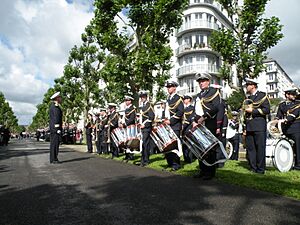
The main military band of the French Navy is the Military Band of the Toulon Fleet. It was founded on July 13, 1827. The Bagad Lann Bihoue, which is based on the traditional bagad bands from Bretagne, is the only pipe band in the French Navy. It uses bagpipes and bombards.
France's financial situation has affected all parts of its military. The 2013 French White Paper on Defence and National Security cancelled plans for a new aircraft carrier and a possible fourth Mistral-class amphibious assault ship. The main ships of the fleet will be the Aquitaine-class FREMM anti-submarine frigates. These are replacing older ships. Plans to buy 17 FREMMs were reduced to eight.
The cancellation of two other destroyers meant that the last two FREMM hulls, which entered service between 2021 and 2023, are now air-defence ships. These new ships will replace the Cassard class class. Funds for more FREMMs are now being used for five more Frégate de Défense et d'Intervention (FDI, "intermediate size frigates"). These ships are being delivered from 2024 to supplement and eventually replace the La Fayette class. Three of the La Fayette class ships are being upgraded to operate until the early 2030s.
For support ships, the Durance class class is being replaced by up to four new ships. Three of these are being delivered between 2023 and 2027. Construction has started on the first of six Barracuda-class nuclear attack submarines. The Suffren was commissioned in 2020. These nuclear attack submarines will be followed in the 2030s by a new class of nuclear-powered ballistic missile submarines (SSBNs). Construction for these began in 2024.
New missiles are also being developed. The first MM40 Exocet Block 3 missile was tested in 2010. Naval versions of the SCALP EG land-attack cruise missile are being developed. There are also plans for an Aster Block 1NT missile with better abilities against ballistic missiles.
In October 2018, the French Ministry of Defence started a study for a future replacement for the aircraft carrier Charles de Gaulle after 2030. President Emmanuel Macron decided in 2020 to build the new carrier. It is expected to start service in the late 2030s and remain in use beyond 2080. Construction of the new carrier began in 2025.
- Admiral Jean de Vienne—admiral during the Hundred Years' War.
- Admiral d'Estaing—helped the United States gain independence.
- Admiral de Grasse—commander at Chesapeake Bay during the American Revolutionary War.
- Vice-Admiral Tourville—commander at the Battle of Beachy Head.
- Vice-Admiral Villeneuve—commander at the Battle of Trafalgar.
- Vice-Admiral Duquesne—commander at the Battle of Agosta.
- Jacques-Yves Cousteau—famous ocean explorer.
- Philippe de Gaulle—son of General Charles de Gaulle.
- Alain Delon—actor, served as a marine in the First Indochina War.
- Jean Gabin—actor, joined the Free French naval force in World War II.
- Paul Gauguin—painter and writer.
- Albert II, Prince of Monaco—reserve Lieutenant Commander.
- Pierre Loti—famous writer.
- Eric Tabarly—famous yachtsman.
See also
 In Spanish: Marina Nacional francesa para niños
In Spanish: Marina Nacional francesa para niños
- Future of the French Navy
- List of active French Navy ships
- List of French Navy ship names
- History of the French Navy from 1715 to 1789
Marine nationale
- Chief of Staff of the French Navy
- Airborne Units of the French Navy
- Escorteur
- Far East Squadron
- French 100 mm naval gun
- List of aircraft carriers of France
- List of escorteurs of France
- List of French naval battles
- List of Naval Ministers of France
- Standing French Navy Deployments
- Category:French Navy admirals
- Category:French Navy officers
- Category:Naval ships of France



